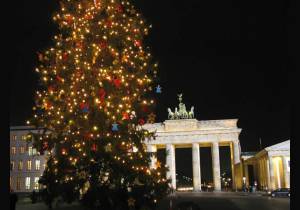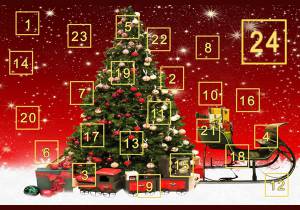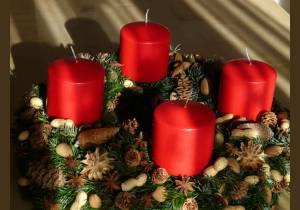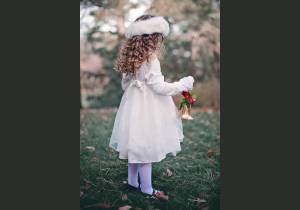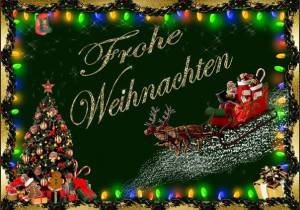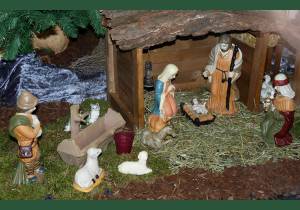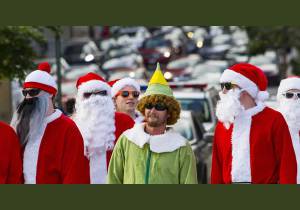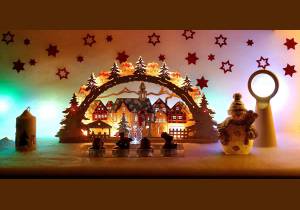Celebrating the Christmas in Germany: dates, celebration, conventional congratulations, greetings, traditions and customs on the Christmas
On this page you will find a description of the Christmas festivities in Germany. Celebration dates by year, customs and traditions common for Germany on the Christmas, a description of the origin, congratulations & greetings.
Dates for the Christmas celebration in Germany
The date of the Christmas celebration in Germany remains unchanged every year and falls on 25 December and 26 December.
The Christmas celebration date in Germany:
25 December and 26 December 2026 .
Below is a list of dates for celebrating the Christmas in Germany by year, provided that in previous and subsequent years the present practice and time of the holiday celebration is preserved:
- (Th) 25 December and (Fr) 26 December 2025 - Christmas 2025Germany Germany
- (Fr) 25 December and (Sa) 26 December 2026 - Christmas 2026Germany Germany
- (Sa) 25 December and (Su) 26 December 2027 - Christmas 2027Germany Germany
- (Tu) 25 December and (We) 26 December 2029 - Christmas 2029Germany Germany
Related holidays
- The 2nd day of Christmas, 26 December 2026
- Advent, 29 November 2026
- The 2nd Advent, 6 December 2026
- The 3rd Advent, 13 December 2026
- The 4th Advent, 20 December 2026
- Christmas Eve, 24 December 2026
Other names of the holiday
Holiday name in German: Weihnachten, 2. Weihnachtstag.
We are not aware of any other names for the Christmas in Germany.
Holiday status in the territory of Germany
Christmas is an extra non-working day (non-working days) throughout Germany – it’s a national holiday.
Wishes and congratulations, greetings on the Christmas in Germany
In Germany, it is common practice to write each other Christmas greeting cards. The major wishes on the postcards are as follows:
- Fröhliche Weihnachten und ein glückliches neues Jahr!
(Merry Christmas and Happy New Year!) - Merry Christmas and a Happy New Year! (the same, yet, in English)
- Frohe Weihnachten!
(Merry Christmas!)
On the German Internet, you can find a lot of texts that are used for Christmas greetings: meant for relatives, friends, workfellows, and so on.
Description of the Christmas celebration: customs and traditions:
Holiday name and time of celebration
The German word for Christmas "Weihnachten" might probably be derived from the phrase "Ze wihen nahten" and literally means "in the holy nights", it refers to the 12 nights from December 25th to January 6th.
In Germany, overnight December 24 into December 25 morning is called "Heiligabend", translated as "Sacred evening", i.e. Christmas Eve; at this time the holiday itself is celebrated and Christmas gifts are exchanged (in German: Bescherung or Christkindchen).
The beginning of the pre-Christmas period falls on the 4th Sunday before Christmas, this time is called Advent (in Latin - "coming"), see the dates of Advent in Germany by year. This is how people celebrate each of the 4 Sundays preceding Christmas.
Thus, the Christmas period in Germany lasts over a month. The major dates of this period are shown in the table below:
| Time period | Description |
|---|---|
| 4th Sunday before Christmas, falling on November 27 - December 3 | The beginning of the pre-Christmas period (Advent season), preparing for Christmas |
| December 6 | St. Nicholas Day, he is considered the foretype of Santa Claus, Father Christmas or Kriss Kringle. |
| December 24 | Yule-even, Christmas Eve, festive table and exchanging gifts. |
| December 25,26 | A national holiday in Germany, days free from work. |
| December 31 | Sylvester - New Year's Eve |
| January 1 | New Year's Day is a national holiday in Germany, a day free from work. |
| January 6 | The Feast of the Three Kings, the last day of the Christmas period. It is an official public holiday and a day off in some federated states (regions) of Germany. |
Christmas customs and traditions
Christmas customs and traditions begin as early as the preparations for the holiday from the 4th Sunday before Christmas, the First Day of Advent. The most common customs are as follows:
- Lighting candles on an Advent wreath (Adventskranz) made of spruce branches. The wreath contains 4 red candles, each of which is lit in turn on each of the 4 Sundays preceding Christmas: on the first - one, on the second - two, and so on.
- Christmas calendar for children (Adventskalender), this calendar has little windows that children open every day from December 1st to December 24th to take out sweets therefrom.
- Arch-shaped lampstands (Erzgebirgischer Schwibbogen) with Christmas motifs – are displayed on windowsills of houses.
- On Advent Sundays, religious or gospel songs are sung in churches, and are also broadcast on radio and television.
Families celebrate this holiday in different ways, usually putting up a fir tree and decorating it with toys, preparing a festive dinner and setting up pictures or figurines with a Christmas storiation (Weihnachtskrippe) at home. Some celebrate Christmas in privy with their family; others prefer a big group of friends. At Christmas, people give each other gifts. Churches host Christmas masses and Christmas carols, as well as performances related to the Nativity (Krippenspiel, Christvesper).
In Germany, it is customary for children to write letters of wishes to Nikolaus, the Christ Child, Santa Claus or another Christmas character. To this purpose, the German post service the Deutsche Post AG provides addresses where these letters are actually sent and from where the children receive replies. Follow this link to find out the addresses for sending letters on the Deutsche Post official website.
The Christmas market or fair (Weihnachtsmarkt) is another essential attribute of the Christmas period in Germany. It sells sweets and pastries, Christmas tree decorations, and people drink glogg (Glühwein), a traditional sweet hot wine-based Christmas drink. The markets are usually beautifully decorated and have an original Christmas program.
Who gives gifts for Christmas in Germany?
Different characters bring greetings and gifts to children at Christmas, depending on the region of Germany.
In the south of Germany, the Christ Child(in German: Christkind) brings gifts, he is featured or participates in live performances as an angel-girl wearing a white dress, having white hair.
In the north and in the centre of Germany, gifts are brought by Father Christmas or Santa (in German: Weihnachtsmann), wearing a red fur coat, a red cap and a long white beard. He is called Saint Nicholas (in German: Nikolaus) or Santa Claus (in German: Santa Claus). Nicholas is sometimes accompanied by Knecht Ruprecht (in German: Knecht Ruprecht), usually presented as a servant and assistant of St. Nicholas, he looks like a man with a dark face, a long beard, dressed in fur or covered with straw, he has a long staff and a bag of ash. Knecht Ruprecht – is the antitype of Nikolaus, the opposite of good - one of the Devil’s names, which earlier used to be common in Germany; this assistant plays the role of a punisher for disobedient children.
Festive table at Christmas, sweets
A festive Christmas dinner is also long established; in Germany they usually cook: Christmas goose, ham or carp. They also like potato salad with sausages.
Christmas in Germany uses special pastries and sweets containing marzipan, nuts, honey, dried fruit, raisins, as well as spices: aniseed, pepper, nutmeg, and cloves. Stollen is the most traditional Christmas cake.
Many foods matter symbolically and are believed to bring happiness.
The origin of the Christmas holiday
Paradoxically, both the Christmas holiday per se and most of the traditions and customs associated with it have little to do with the birth of Jesus Christ. And this is true not only for Germany, but all over the world.
Celebration date: December 25 (earlier it used to be the day of the winter solstice, the Sunreturn), had an important religious meaning for many pagan peoples, on this day they celebrated their birthday and worshiped various deities. The biblical texts do not mention the date of Christ's birth, although some refer the real birthday of Christ to the fall, supposedly to the months of September or October.
Christmas precursors: The Egyptians celebrated the birth of Horus by the mother goddess Isis; the Greeks honoured their sun god Helios; in Asia they celebrated the day of the Indo-Iranian sun god Mithras; and the Romans celebrated the day of the invincible sun god Saturn.
The Germanic tribes used to celebrate the winter Yule festival (in German: Julfest), which is why in some Scandinavian countries Christmas is still called Jultid. This holiday celebration lasted for 12 days from December 25 to January 6.
Christmas first celebrations date back to the 3-4th century AD. According to the researchers, Christmas became a church holiday in the German-speaking world from about the 9th century AD, and began to be celebrated in a family setting from the 14th century.
In Christianity, Christmas was originally celebrated on January 6, which day is now called Epiphany or the Feast of the Three Kings. And then its date was rescheduled to December 25, Christians are believed to have wanted to convert pagans to Christianity, and therefore set the date of celebration for December 25, the day of honouring the sun god. However, along with the date, Christmas borrowed a lot of pagan customs and traditions that have nothing to do with Christianity.
Many of the Christmas attributes have also been borrowed from the Christmas precursors, the birthdays of the sun and other deities. For example, the prototypes of a number of Advent customs in Germany are the rituals that used to be part of the Yule holiday symbolism, as well as those of the midwinter holiday of the ancient Germanic peoples, which included: a Yule log with candles, evergreens, ivy hung on the door, etc.
Photos, pictures for the holiday
To enlarge and view the picture, click on it with the mouse button.
-

Christmas market in Germany, Dresden
-

Berlin, Christmas tree
-

Christmas calendar for kids
-

Christmas wreath with candles
-

Christ Child (Christkind)
-

Christmas greeting card
-

Christmas baked goods, Stollen
-

Figurines with a Christmas storiation (Weihnachtskrippe)
-

Santa Claus accompanied by an elf
-

Arch-shaped Christmas lampstands
RU-GELD.DE Team
Last updated:

